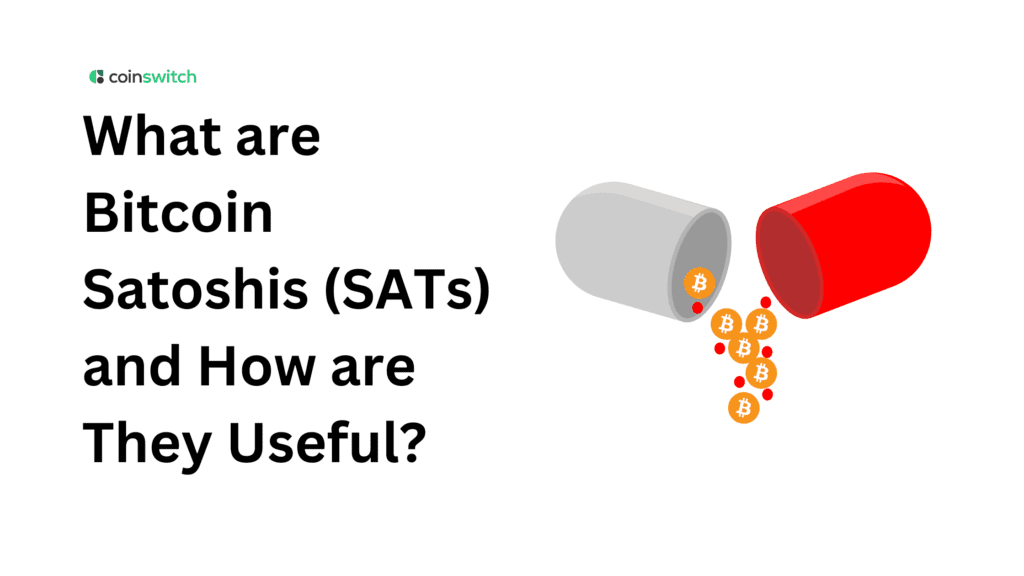The complete guide to Bitcoin Satoshis (SATs)
Digital gold needs fine granularity. Enter the satoshi, Bitcoin’s smallest unit. This unit makes ownership flexible, accessible, and efficient across all use cases, regardless of size.
Every Bitcoin equals 100 million satoshis. That means each SAT is one hundred millionth of a Bitcoin. While BTC signals macro value, satoshis bring micro precision. Bitcoin breaks billions into millions, giving digital currency the finesse mainstream users demand.
Think of satoshis like cents to a dollar. They let you transact in tiny increments. Want to tip an artist, pay for a tweet, or send a fraction to a family member overseas? SATs make it smooth, cheap, and trackable.
This guide covers everything from definition to impact. We’ll discuss what are satoshis, why they matter, how they tie into Bitcoin’s limited supply, real-world use cases, and the most straightforward steps to start accumulating them, or that neat “sat coin” idea some platforms use to gamify savings.
Let’s break it down.
Importance of Bitcoin Satoshis
Bitcoin satoshis unlock practical, everyday access to digital wealth. While one Bitcoin feels heavy for many, SATs break it down into smaller, usable pieces that fit every budget and use case.
These tiny units, 100 million per Bitcoin, make digital currency feel familiar and usable. From buying a snack to tipping online, SATs powers quick, frictionless payments across apps, games, and platforms. They help people transact in amounts that match real-life value, not just investment-level chunks.
SATs improve financial flexibility. With them, users can send 1,500 SATs to support a creator, pay 12,400 SATs for a digital collectible, or set aside 9,000 SATs daily into a savings plan. Each action fits into routine habits, something a full Bitcoin couldn’t easily offer.
Retail pricing becomes more precise with SATs. Merchants can list services or goods at exact numbers, down to every satoshi, without awkward conversions. SATs also support vending, event tickets, and usage-based billing in IoT or gaming spaces.
Programmable finance benefits from SAT granularity too. Smart contracts, DeFi tools, and blockchain-powered billing often rely on SATs to calculate costs or rewards with surgical accuracy. The finer the unit, the smoother the code runs.
Digital wallets now show balances in SATs, creating familiarity through whole numbers. This boosts trust, ease, and daily engagement, especially for first-time users.
Most importantly, SATs promote inclusion. In countries with unstable currencies or limited access to traditional banking, holding SATs offers a new kind of stability. People can join the Bitcoin ecosystem in amounts that feel realistic and empowering.
When you explore what are satoshis, you’re actually discovering the tool that makes Bitcoin truly usable. These units bridge the gap between a global asset and a daily-use currency. They carry the same strength, just in a friendlier, more flexible form.
Satoshis and Bitcoin’s Limited Supply
Bitcoin’s 21 million cap sets the tone for its entire ecosystem. It signals digital scarcity, a finite resource in a world of unlimited fiat. But it’s the satoshi, its smallest unit, that brings clarity, usability, and scale to this model.
There are 2.1 quadrillion SATs in existence. That number unlocks precision. Even with Bitcoin’s limited supply, satoshis allow everyone to participate, whether trading ₹100 or ₹10 crore. It’s the kind of design that protects scarcity while staying accessible.
Read More: Satoshi Nakamoto: Who He Is, Net Worth, & His Bitcoin Holdings
Why SATs Matter in a Fixed Supply System:
- Fractional Flexibility: As Bitcoin prices climb, SATs make microtransactions possible. You don’t need to own a whole coin to use or save BTC.
- Inflation Defense Mechanism: When market prices spike or shift, SATs absorb shocks. You can still buy coffee, pay a creator, or make small transfers without rounding issues.
- Miner Rewards: Every new block reward is measured in BTC, but truly felt in SATs. This keeps the network functional with crystal-clear accounting, especially after each halving.
- No Decimal Headaches: Most assets need patches to allow micro values. Bitcoin skips the workaround. SATs are native. Every platform, wallet, and protocol gets a uniform standard.
Even at $1 million per BTC, 1 satoshi still holds measurable, usable value. That foresight is rare. Bitcoin doesn’t just rely on a limited supply; it magnifies its utility through subdivision.
Satoshi’s anchor usability. They make Bitcoin more than a long-term store. They build the bridge for daily use, micro-savings, and programmable finance. Each SAT becomes a usable, trackable, and divisible slice of the world’s most well-known digital asset.
Bitcoin’s scarcity gets all the headlines. But satoshis? They carry the weight of the system, billions at a time.
Practical Examples and Use Cases of Satoshis
SATs aren’t just digital decimals. They move through real platforms, apps, and wallets, powering features that feel human, useful, and tangible.
1. Tipping Culture
On platforms like Nostr or Lightning-powered social apps, tipping happens in SATs. Someone drops a thoughtful comment or shares a solid meme, you send them 100 SATs right from your wallet. It’s instant, doesn’t need conversion, and builds a culture of digital appreciation. That gratitude, small, trackable, and real, flows across borders in seconds.
2. In-Game Economies
Games now reward players in SATs for leveling up or completing missions. Users stake a few thousand SATs to unlock new skins or boost gear. Winning becomes more rewarding when the currency is Bitcoin-backed. The SAT economy inside games feels organic, where players earn, spend, and save, just like real-world money, but smarter.
3. Pay-Per-Use Models
APIs, cloud tools, or data calls often charge per request. Instead of flat monthly fees, these services use SATs. Make an API call? That’s 25 SATs. Store a file? Another 40 SATs. Users only pay for what they use. SAT precision supports atomic transactions, perfect for microservices and scalable access.
4. IoT Payments
Smart devices are getting smarter with SATs. A solar panel sends excess power to a neighbor and earns 1,200 SATs. A fridge restocks itself and tips a logistics service. These payments happen in real-time between machines. This is machine finance, SAT-powered, real-time, and borderless.
5. Savings Automation
Apps convert leftover change into SATs. Spend ₹92.50 at a store? The remaining ₹7.50 rounds into SAT savings. Every swipe, every transaction builds a tiny stack. “Sat coin” wallets automate this, turning habits into long-term stacks without changing lifestyle. That’s micro-saving with macro impact.
6. Remittance Flows
Want to send $10 to someone overseas? That’s about 200,000 SATs. No delays, no paperwork. Transfers hit wallets in minutes, with ultra-low fees. Unlike traditional remittance services, SATs make it fast, transparent, and fair. Each SAT keeps its value, and each transfer happens with precision.
7. Merchant Pricing
At Bitcoin-friendly cafes or e-stores and website, prices come tagged in SATs. A coffee? 2,500 SATs. A digital sticker pack? 800 SATs. No cents, no confusion. With apps displaying real-time BTC rates, merchants and buyers speak the same SAT language. It simplifies change, automates tax, and removes friction.
8. Charity Micro Donations
A fundraising page collects donations from anyone willing to help. Donations come in 300 SATs, 700 SATs, or 1,500 SATs, small amounts that add up fast. Since all transfers are visible on-chain or in-app, donors know exactly where their support goes. It’s grassroots philanthropy powered by micro transactions.
From micro-rewards to global transfers, SATs step in where traditional currency steps back. They’re programmable, transparent, and already woven into daily use, across games, wallets, devices, and human connections. These practical examples cover both human and machine economic activity. SATs form the bridge. They make Bitcoin act like money, for real life.
Read More:
Start Buying Bitcoin
Ready to buy Bitcoin on CoinSwitch, India’s largest crypto app?
1. Open the CoinSwitch app
It’s your trusted exchange for buying Bitcoin in seconds.
2. Add funds to your wallet
Use UPI, bank transfer, or card, whatever suits your flow.
3. Select your amount.
Go with ₹100, ₹500, or ₹1,000, as you wish.
4. Confirm and receive.
Your wallet reflects the quantity of BTC purchased.
Conclusion
Sat units turn Bitcoin into versatile money. They uphold scarcity while maximizing accessibility. They make micro payments, developer tools, gaming economies, remittance channels, and savings automation shine.
When you think about what SATs are, remember: SATs are freedom in increments. They democratize Bitcoin, let flows adjust finely, and power finance at any scale.
Start with a small stack. Watch as satoshis add up, and power your journey into digital value, no leap required, just step by step.
FAQs
1. What is the use of the SATS coin?
SATS coin helps users buy, send, and save tiny Bitcoin units. It powers micro transactions, tipping, savings apps, and daily payments across supported wallets and platforms.
2. What are the benefits of Satoshi?
Satoshis offer accessibility, micro-level pricing, and precise transactions. Anyone can own them, use them for payments, or save gradually without needing large Bitcoin amounts.
3. How much will one satoshi be worth?
The value of one satoshi depends on Bitcoin’s price. If Bitcoin hits $100,000, one satoshi equals $0.001. It adjusts constantly with price changes.
4. What’s the difference between sats and Bitcoin?
Sats are the smallest units of Bitcoin. One Bitcoin equals 100 million sats. Both represent the same assets—sats just make it easier to handle smaller amounts.








